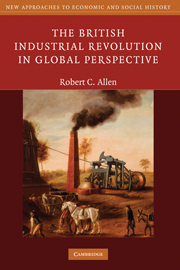Book contents
- Frontmatter
- Contents
- List of plates
- List of figures
- List of tables
- Acknowledgments
- 1 The Industrial Revolution and the pre-industrial economy
- Part I The pre-industrial economy
- Part II The Industrial Revolution
- 6 Why was the Industrial Revolution British?
- 7 The steam engine
- 8 Cotton
- 9 Coke smelting
- 10 Inventors, Enlightenment and human capital
- 11 From Industrial Revolution to modern economic growth
- References
- Index
10 - Inventors, Enlightenment and human capital
Published online by Cambridge University Press: 05 June 2014
- Frontmatter
- Contents
- List of plates
- List of figures
- List of tables
- Acknowledgments
- 1 The Industrial Revolution and the pre-industrial economy
- Part I The pre-industrial economy
- Part II The Industrial Revolution
- 6 Why was the Industrial Revolution British?
- 7 The steam engine
- 8 Cotton
- 9 Coke smelting
- 10 Inventors, Enlightenment and human capital
- 11 From Industrial Revolution to modern economic growth
- References
- Index
Summary
I saw the field was spacious, and the soil so good, as to promise an ample recompence to any one who should labour diligently in its cultivation.
Josiah WedgwoodThe rate of invention is determined by the supply of inventors as well as by the demand for new products and processes. Britain's unique structure of wages and prices led to a demand in the eighteenth century for techniques that substituted energy and capital for labour, and that was an important cause of the technological breakthroughs of the Industrial Revolution. But why was there a supply response? Why did inventors come forward to meet the challenges? These questions require attention, for eighteenth-century Britain was not unique in being a high wage economy. Europe after the Black Death is an important case in point, for wages were extremely high (Figures 2.2, 2.3 and 2.5) and yet there was no Industrial Revolution. While the lack of a coal industry was an important difference, another was a more limited supply of potential inventors. The ‘aspirational’ theory of Sir James Steuart discussed in Chapter 1 implies that the absence of consumer goods in the late middle ages reduced work effort. The situation was reversed in the seventeenth century when the greater variety of British and imported consumer goods triggered an ‘industrious revolution’ that was manifest in more active inventing.
- Type
- Chapter
- Information
- The British Industrial Revolution in Global Perspective , pp. 238 - 271Publisher: Cambridge University PressPrint publication year: 2009



